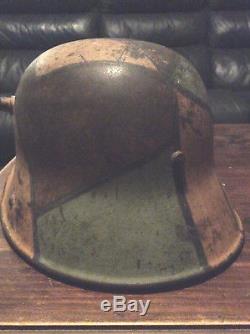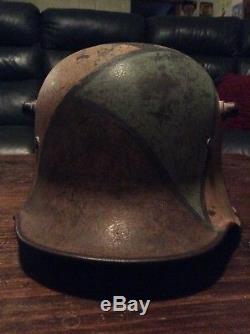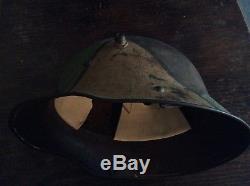German Ww1 Camouflage Stormtrooper Helmet













Original German WWII Camouflage Painted Helmet Name Inscription Hefsler. Brought home as war booty by bronze star winner, G. Psiropoulos of 3rd Army 3rd Infantry Division 3rd Squad. Please take a moment to enlarge and view all the detailed pictures. Type of Piece: WWII German Helmet. Steel helmets: A painted surface with one color e. Green or light brown or with small splotches of a variety of colors is superior to a standard single color helmet, although it still allows the recognition of the characteristic form and silhouette.
In this regard, a three-colored surface which has had the borders blended, simulating a shadow effect is not recognizable beyond a distance of 60 meters. Particulars regarding a useful surface: Dull colors the helmet must not shine. Sprinkling the still-damp oil paint with fine sand stops the surface from glistening in the sun. The choice of colors is to be purposely changed according to the time of year.
One of the three colors must match the basic color found in the region of fighting. Suitable at this time: green, yellow ochre, rust brown Separation of the surface of the helmet into equal-sized portions, consisting of large, sharp-cornered patches.
Support On the front side of the helmet, no more than four colored fields must be visible. Light and dark colors are to be placed next to each other. The colored segments are to be sharply separated from each other by a finger-wide black stripe. Necessary coloring materials for 1000 helmets: 5 kilograms each of ochre, green and brown; 2 kilograms of black. After ongoing scientific testing, I have requested the War Ministry to regulate the appropriate seasonal color scheme.Until that point, I request that painting be carried out in the above-mentioned manner. (signed) Ludendorff To: all Army Groups (5 each) all Army High Commands (20 each) Inspector General of Artillery Schools General of Pioneers attached to General Headquarters Commanding General of the Air Forces Army Mortar School Commander of the Gas Troops M. SS Command Rozoy General Staff Course Sedan Field Artillery and Foot Artillery Practice Grounds Chief of Field Transportation Offices la, Ic, B, Munitions. Z, P, F, Illb (3 each). Today collectors have identified several variations of camouflage patterns found on original helmets.
They are known as tortoise shell, stained glass, window pain, blotch or splotch and lozenge camo. It is probably that depots and individual soldier painted their helmets with patterns that matched their particular skill set, which may explain the numerous patterns.
Although the Ludendorf directive was clear on which colors were to be used variations exists on original helmets. This maybe the result of the availability of certain colors at the front to the need to choose colors which blended into the setting where the individual found himself. Original helmets found having document service on the Italian front have been known to feature hues of blue, stone gray and white, colors which would have blended in well in the alpine stetting. In conclusion attesting the superior protection offered by the M16 and both M18 model helmets, these helmets continued to be worn long after the end of WWI.Both models would see future service with slight modifications in the Reichwehr as well as in Hitlers armed forces during WWII. The design also served as the basis for future German steel helmets, and its influence can even be seen today on the Kevlar helmets worn by U. The item "GERMAN WW1 CAMOUFLAGE STORMTROOPER HELMET" is in sale since Monday, July 2, 2018.
This item is in the category "Collectables\Militaria\1914 - 1918 (WWI)". The seller is "soylentgreen73" and is located in Goolwa, SA. This item can be shipped worldwide.- Product Type: HELMET
- Authenticity: Original
- Era: 1910s
- Country: Germany

